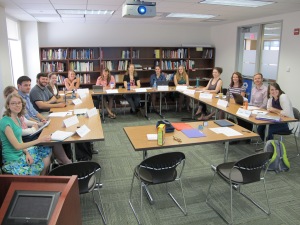
Historic Site Interpretation Class, Fall 2014, Museum Studies Program, George Washington University.
My annual fall class on interpreting historic sites and house museums started yesterday at George Washington University, and as usual, I’ve made some revisions to the course syllabus. Not only does my thinking continue to evolve through my experiences working with sites across the country and from the work of my colleagues in the field, but my students provide a lengthy evaluation at the conclusion of each semester.
I’ve increasingly found that in our efforts to create programming and activities that engage the public at historic sites, we often forget why we’re doing it. After all, if you don’t know why you’re interpreting an historic site, it’s very difficult to know how to do it well. So this year I’m starting the course with the writings of three different people who were passionate about history and saw historic places as meaningful and valuable aspects of our lives: Ada Louise Huxtable, Dolores Hayden, and Gerda Lerner. My students had never heard of any of them, so I’m delighted to introduce them for our study of historic site interpretation. In case you want to read along, here are the first week’s assignments:
- “Where Did We Go Wrong?” (1968) and “Lively Original Versus Dead Copy” (1965) in Goodbye History, Hello Hamburger by Ada Louise Huxtable (1986)
- “Contested Terrain,” chapter 1 in The Power of Place by Dolores Hayden (1995)
- “Why History Matters,” chapter 12 in Why History Matters by Gerda Lerner (1997)
This class will be reading dozens of articles this semester but we also have a set of core books:
- Interpreting Historic House Museums edited by Jessica Foy Donnelly (Altamira, 2002)
- Design for How People Learn by Julie Dirksen (New Riders, 2012)
- Interpretation: Making a Difference on Purpose by Sam H. Ham (Fulcrum, 2013)
Donnelly’s book, alas, is now a dozen years old and it’s becoming more difficult to assign. It still contains good ideas but the case studies are aging, the impact of the Internet is barely felt, and the growing emphasis on visitor research, intentionality, and social relevance are not addressed adequately. And surprisingly, so many of the authors have left the museum field (what does that say about our profession?). If you’ve found a good book on the theory and methodology of interpreting historic sites suitable for graduate students, please share it in the comments below.
